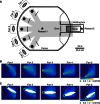Whiskers aid anemotaxis in rats
- PMID: 27574705
- PMCID: PMC4996642
- DOI: 10.1126/sciadv.1600716
Whiskers aid anemotaxis in rats
Abstract
Observation of terrestrial mammals suggests that they can follow the wind (anemotaxis), but the sensory cues underlying this ability have not been studied. We identify a significant contribution to anemotaxis mediated by whiskers (vibrissae), a modality previously studied only in the context of direct tactile contact. Five rats trained on a five-alternative forced-choice airflow localization task exhibited significant performance decrements after vibrissal removal. In contrast, vibrissal removal did not disrupt the performance of control animals trained to localize a light source. The performance decrement of individual rats was related to their airspeed threshold for successful localization: animals that found the task more challenging relied more on the vibrissae for localization cues. Following vibrissal removal, the rats deviated more from the straight-line path to the air source, choosing sources farther from the correct location. Our results indicate that rats can perform anemotaxis and that whiskers greatly facilitate this ability. Because air currents carry information about both odor content and location, these findings are discussed in terms of the adaptive significance of the interaction between sniffing and whisking in rodents.
Keywords: airflow; behavior; hair; navigation; rodents; somatosensory; tactile; vibrissa; vibrissae; wind following.
Figures



References
-
- Casas J., Dangles O., Physical ecology of fluid flow sensing in arthropods. Annu. Rev. Entomol. 55, 505–520 (2010). - PubMed
-
- Budick S. A., Reiser M. B., Dickinson M. H., The role of visual and mechanosensory cues in structuring forward flight in Drosophila melanogaster. J. Exp. Biol. 210, 4092–4103 (2007). - PubMed
-
- Sane S. P., Dieudonné A., Willis M. A., Daniel T. L., Antennal mechanosensors mediate flight control in moths. Science 315, 863–866 (2007). - PubMed
-
- Dehnhardt G., Mauck B., Hanke W., Bleckmann H., Hydrodynamic trail-following in harbor seals (Phoca vitulina). Science 293, 102–104 (2001). - PubMed
Publication types
MeSH terms
Grants and funding
LinkOut - more resources
Full Text Sources
Other Literature Sources

